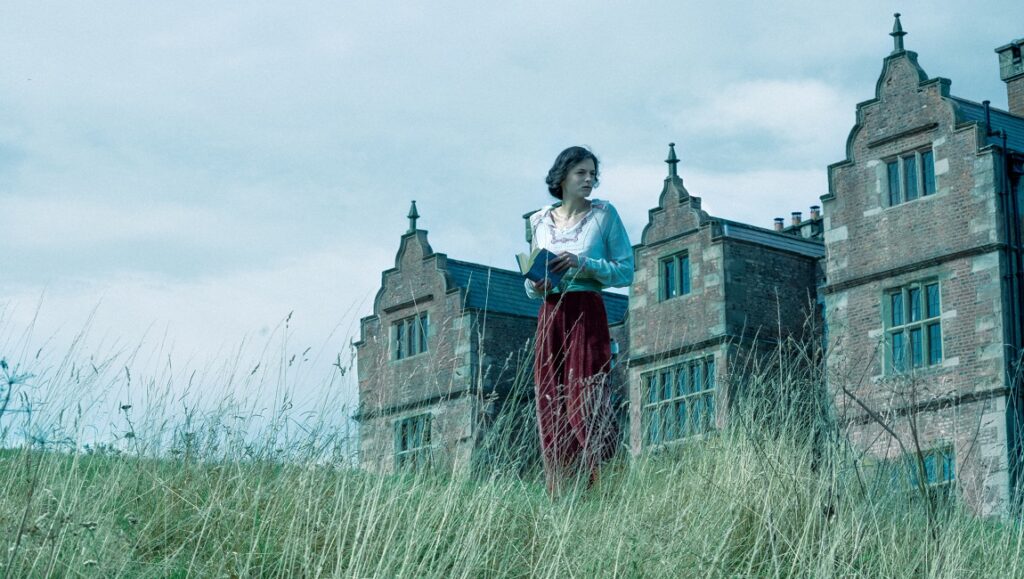Lady Chatterley’s Lover makes the mistake of relying heavily on its source material’s action without understanding either its playfulness or seriousness.
A Reader’s Digest gloss of D.H. Lawrence’s final novel, Lady Chatterley’s Lover, as rendered by Laure de Clermont-Tonnerre, delivers a breakneck plot with an air of total inevitability. “Connie” gains the title of Constance Chatterley by marrying Sir Clifford, the first world war happens, the spark between them fizzles out before it has a chance to ignite, Constance meets Mellors, an earthy gamekeeper, etc. This approach, which one might describe as light on its feet, runs away from the challenge of adapting a novel like Lawrence’s; there is no tension in the book’s progression, but rather in the way it positions its characters’ desires as actions, totally integrated into a confrontational way of life. Of course, the adaptation of a well-known literary text always presents an opportunity for a director to camouflage an undeveloped point of view, and for Clermont-Tonnerre, coming off the somewhat acclaimed prison-rehabilitation tale The Mustang, there is more than enough material to hide behind.
Perhaps there is always something a little unfair about using literary comparison to dismiss a film version; it repeats the equivalency Lawrence himself made in the novel, of celluloid as a metaphor for cheapness. But a director (or her screenwriter, David Magee, of Finding Neverland and Life of Pi notoriety) is the one who gets the first stab at what to make of the material. And, in this case, Clermont-Tonnerre capitulates to the text: just about every scene, many of which are condensed into montages and abbreviated exchanges, has a line-by-line referent in the novel.
Which isn’t the same as being faithful, exactly. Desiring a more straightforward and lean adaptation than Ken Russell’s or Pascale Ferran’s (not to mention Sirk’s All That Heaven Allows), Clermont-Tonnerre makes two key cuts. Constance takes a lover, we expect, but here she takes the first available man she sees. Lawrence grants her an early fling, as part of an extended early sequence in which she inhabits the intellectual circles her husband only plays at being a part of, as well as a Venice conspiracy that tests her ability to spot the counterfeit impulses in her ball of tangled responsibilities. Emma Corrin and Jack O’Connell, the film’s two leads, can hardly be blamed for going through the motions, as this decision paints Corrin’s Chatterley as something rather lesser than the decisive, unashamed Eve she can be interpreted as.
And then there’s the sex. One doesn’t have to follow the path of Jaeckin to know that Lawrence’s novel is a quandary as a visual adaptation because of what it demands: if not bowdlerized, the scenes between Connie and Mellors also have to stand in for a thesis, of fucking as a way of activating a knowledge of life, nature, and identity that can’t be achieved by any other means. In Clermont-Tonnerre’s film, it’s just “good” sex, though even then the climaxes are shied away from. One doesn’t necessarily expect Constance and Mellors’ soliloquies on the cunt, the penis, and the arse to remain intact, but Clermont-Tonnerre decides against even slipping their pet names into the dialogue (crucial to the novel’s memorable final line).
And so, by relying so heavily on Lawrence’s novel’s events, but taking a disinterest to both its playfulness and seriousness, this version of Lady Chatterley’s Lover is essentially anonymous. It can’t even begin to imagine an access point to the lexicon of tragedy and transgression that the text invites.
You can stream Laure de Clermont-Tonnerre’s Lady Chatterley’s Lover on Netflix beginning on December 2.


Comments are closed.